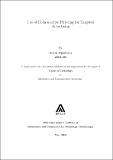Please use this identifier to cite or link to this item:
http://drsr.daiict.ac.in//handle/123456789/206| Title: | Use of collaborative filtering for targeted advertising |
| Authors: | Jotwani, Naresh D. Upadhyay, Ankur |
| Keywords: | Advertising Finance Statistical methods Bayesian statistical decision theory Data processing Marketing Statistical methods Advertising Mathematical models Information technology |
| Issue Date: | 2008 |
| Publisher: | Dhirubhai Ambani Institute of Information and Communication Technology |
| Citation: | Upadhyay, Ankur (2008). Use of collaborative filtering for targeted advertising. Dhirubhai Ambani Institute of Information and Communication Technology, viii, 51 p. (Acc.No: T00169) |
| Abstract: | Often in our daily life, we come across situations when we have many options available and are expected to choose one of them. May it be a bookstore, CD shop or a shopping store, even on the internet, the availability of so many genres and a wide variety among every genre poses difficulty in selection of the item. Recommender systems have been providing suggestions but they are not able to provide us options when we are walking through the aisles of a bookstore or a CD shop. Ideally, recommendations should be made available to the customer without giving explicit command. To provide ease while walking down for shopping in selecting the items based on the item chosen by the customer, the topic focuses on deriving a general model for recommending a product that might save customers money and time along with fulfilling the need. Selection of the product to be advertised by the model is a dynamic decision as it depends on the products kept in the basket. Bayesian approach is used to find the dependencies between items which implements Collaborative filtering and provides real time recommendations on the basis of preferences of earlier customers. The model uses Clustering to limit the complexity of the model that will be built and to aggregate similar items, by grouping customers those who bought items of similar genre. The assumption made is that the selection of the customer is made known to the model in order to process it, to give recommendations; and the recommendations are made known to customers using suitable advertising mechanism. |
| URI: | http://drsr.daiict.ac.in/handle/123456789/206 |
| Appears in Collections: | M Tech Dissertations |
Files in This Item:
| File | Description | Size | Format | |
|---|---|---|---|---|
| 200611038.pdf Restricted Access | 485.7 kB | Adobe PDF |  View/Open Request a copy |
Items in DSpace are protected by copyright, with all rights reserved, unless otherwise indicated.
